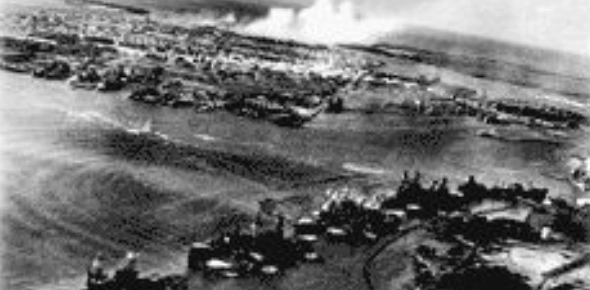Modern World History Quiz # 1

A quick quiz that will test your knowledge of Modern World History. . So C'mon, get those brain cells firing!
- 1.
'Pearl Harbor' took place on 7th December, 1941. President Roosevelt called it "a date which will live in infamy." What was Pearl Harbor?
- A.
Japanese attack on US naval base at Oahu Island
- B.
Vietnamese Vietnamese victory in the war against US in Vietnam, Loas and Cambodia
- C.
Arab attack led by Egypt and Syria on US ally Israel
Correct Answer
A. Japanese attack on US naval base at Oahu IslandExplanation
Pearl Harbor refers to the Japanese attack on the US naval base located at Oahu Island on December 7th, 1941. This attack is famously known as "a date which will live in infamy" as stated by President Roosevelt. The attack resulted in significant damage to the US Pacific Fleet and led to the United States' entry into World War II.Rate this question:
-
- 2.
The Treaty of 'San Francisco' was signed in 1945 between America and Italy.
- A.
True
- B.
False
Correct Answer
B. FalseExplanation
The given statement is false because the Treaty of San Francisco was actually signed in 1951, not 1945. This treaty was signed between Japan and 48 other countries, including the United States, but Italy was not one of the signatories. The treaty officially ended the state of war between Japan and the Allied Powers, and it also established the terms for Japan's post-war reconstruction and reintegration into the international community. Italy's involvement in this treaty is incorrect.Rate this question:
-
- 3.
'Appeasment' was the policy followed by the British in order to avoid..
- A.
Being seen as an agressive power
- B.
War with agressive powers such as Japan, Italy and Germany
- C.
A cold war with agressive powers such as France, US and China
Correct Answer
B. War with agressive powers such as Japan, Italy and GermanyExplanation
The policy of appeasement was followed by the British in order to avoid war with aggressive powers such as Japan, Italy, and Germany. This approach involved making concessions and compromises in the hopes of maintaining peace and avoiding conflict. By appeasing these aggressive powers, the British aimed to prevent further aggression and maintain stability in Europe. However, this policy ultimately proved unsuccessful as it only emboldened these powers, leading to the outbreak of World War II.Rate this question:
-
- 4.
Oahu Island is in Hawaii.
- A.
True
- B.
False
Correct Answer
A. TrueExplanation
Oahu Island is indeed in Hawaii. Oahu is the third largest island in the Hawaiian archipelago and is known for its vibrant city of Honolulu, beautiful beaches, and iconic landmarks such as Diamond Head and Pearl Harbor. It is a popular tourist destination and is home to a significant portion of Hawaii's population.Rate this question:
-
- 5.
The 'Cultural Revolution' took place between 1966- 1969 in China.
- A.
True
- B.
False
Correct Answer
A. TrueExplanation
The Cultural Revolution did indeed take place in China between 1966 and 1969. It was a sociopolitical movement led by Mao Zedong with the aim of preserving communist ideology and eliminating perceived capitalist and traditional elements from Chinese society. The movement resulted in widespread social upheaval, political persecution, and economic disruption, causing significant damage to China's cultural heritage and leading to the loss of countless lives.Rate this question:
-
- 6.
Which of the below is not one of the United Nations 6 main organs.
- A.
The Secretariat
- B.
The Economic and Social Council
- C.
The International Council of Peace
Correct Answer
C. The International Council of PeaceExplanation
The International Council of Peace is not one of the United Nations' six main organs. The correct answer is based on the fact that the United Nations' six main organs are the General Assembly, the Security Council, the Economic and Social Council, the Secretariat, the International Court of Justice, and the Trusteeship Council. The International Council of Peace is not recognized as one of these main organs.Rate this question:
-
- 7.
During the First World War, there were two opposing sides: The Allies or Entente Powers and the 'Central Powers'. The 'Central Powers' comprised of..
- A.
Germany, Austria-Hungary, Turkey and Bulgaria
- B.
Germany, Serbia, Turkey and Belgium
- C.
Germany, Austria-Hungary, France and Romania
Correct Answer
A. Germany, Austria-Hungary, Turkey and BulgariaExplanation
During the First World War, the opposing sides were the Allies or Entente Powers and the Central Powers. The Central Powers consisted of Germany, Austria-Hungary, Turkey, and Bulgaria. These countries formed an alliance and fought against the Allies.Rate this question:
-
- 8.
Joseph Stalin of USSR was a dictator from late 1927 unitl his death in 1954 at the age of 75.
- A.
True
- B.
False
Correct Answer
B. FalseExplanation
Joseph Stalin was the dictator of the Soviet Union from the mid-1920s until his death in 1953, not 1954. He died at the age of 74, not 75. Therefore, the statement is false.Rate this question:
-
Quiz Review Timeline +
Our quizzes are rigorously reviewed, monitored and continuously updated by our expert board to maintain accuracy, relevance, and timeliness.
-
Current Version
-
Dec 21, 2023Quiz Edited by
ProProfs Editorial Team -
Oct 07, 2010Quiz Created by
Dimto
 Back to top
Back to top




.webp)
